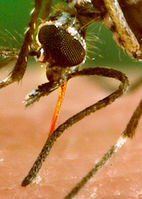Aedes aegypti
| Literature database |
|---|
| 2851 articles sorted by: |
| • year (descending) |
| • research topics |
| • countries/regions |
| • list of natural enemies |

Author(s): James Gathany
Source: Wikimedia Commons
Aedes aegypti Linnaeus, 1762 - (yellowfever mosquito)
The mosquito is widespread in tropical and subtropical areas, possibly originating from sub-Saharan Africa, and an important vector of dengue fever, urban yellow fever and other diseases. It apparently spread to the Americas as part of the colonization of that continent and to Asia in the second half of the 19th century.
It is highly anthropophilic and closely associated with domestic environments, breeding mainly in discarded containers, water storage tanks and other sources of stagnant water around houses. Dark-coloured containers in the shade are preferred.
It bites during the day and prefers to bite indoors. Control inside and around homes relies on:
• reducing breeding sites
• protection against adults with nets, mosquito screens and repellents
• treating breeding sites with chemical or biological larvicides
• applying chemical insecticides against adults.
| Vernacular names | |
|---|---|
| • Deutsch: | Gelbfiebermücke Ägyptische Tigermücke |
| • English: | yellowfever mosquito dengue mosquito |
| • Español: | mosquito de la fiebre amarilla |
| • Français: | moustique de la fièvre jaune |
The larvae feed on organic material in the water like decaying leaves, algae or other organic particles. The original breeding places in Africa were probably tree holes, a behavior still shown by the subspecies Aedes aegypti formosus. The eggs might survive without water for several months. The life cycle from egg to adult emergence is about 2 weeks, but may be as short as one week under suitable conditions.
The adult is around 3-4 mm large. The thorax markings in form of a lyre are characteristic for this species and can be used to distinguish it from Ae. albopictus which has a similar biology and distribution.
Synonyms:
Aedes calopus
Culex aegypti
Ochlerotatus aegypti
Stegomyia aegypti
For details see the respective page in Wikipedia.
- Other images of Aedes aegypti (Wikimedia Commons and PaDIL - click to enlarge)









